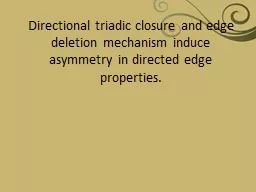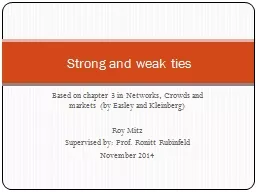PPT-Directional triadic closure and edge deletion mechanism ind
Author : kittie-lecroy | Published Date : 2016-03-22
Directional Networks Two of the most consistent features of real world networks are the scale free degree distributions and the high clustering coefficients In
Presentation Embed Code
Download Presentation
Download Presentation The PPT/PDF document "Directional triadic closure and edge del..." is the property of its rightful owner. Permission is granted to download and print the materials on this website for personal, non-commercial use only, and to display it on your personal computer provided you do not modify the materials and that you retain all copyright notices contained in the materials. By downloading content from our website, you accept the terms of this agreement.
Directional triadic closure and edge deletion mechanism ind: Transcript
Download Rules Of Document
"Directional triadic closure and edge deletion mechanism ind"The content belongs to its owner. You may download and print it for personal use, without modification, and keep all copyright notices. By downloading, you agree to these terms.
Related Documents














